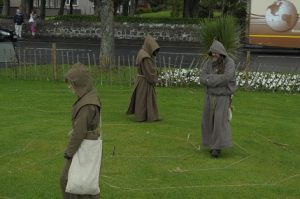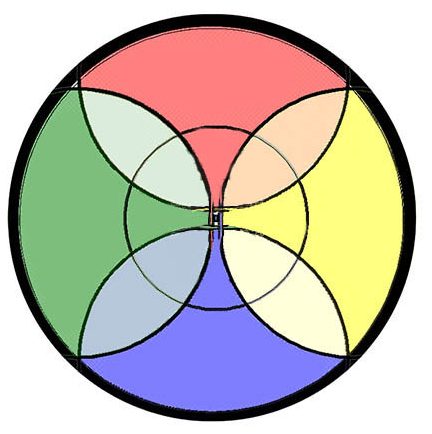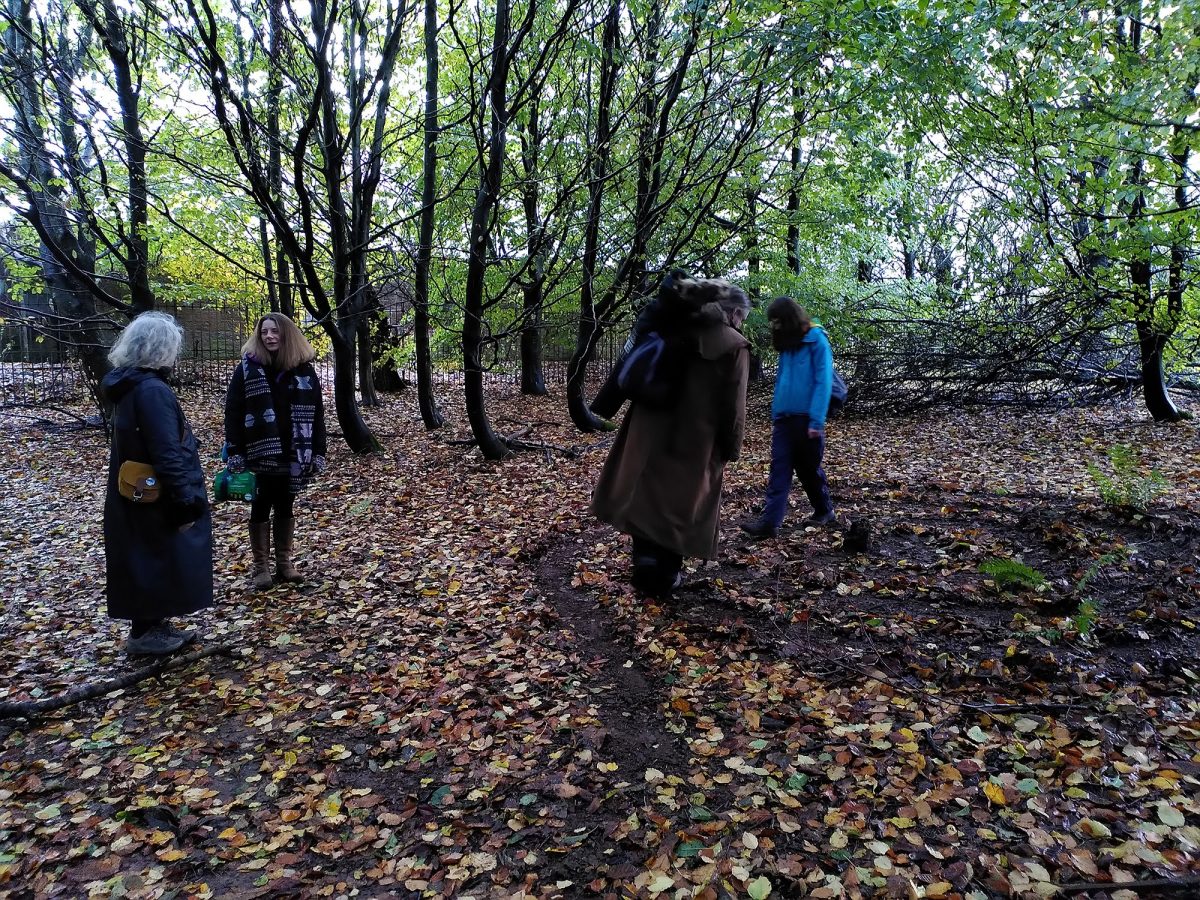
One of the #SensingSpirituality tools we use is Labyrinths. These vary from small ones held in you hand to full size constructions you can walk around. Some of the most famous uses of Labyrinths came about to help people experience pilgrimage when their situation made physical travel difficult. They can be found built into the fabric of Cathedrals such as Chartres . Recently a rediscovery of their roots in folk art dating back to prehistory has inspired people to make many new ones. Explore the range and diversity here.
The challenge in a labyrinth is not how to find your way through a maze on the floor – there is only one way. The challenge is how to use the time you have in the labyrinth to learn more about yourself, God, and your relationships. Some labyrinths simply rely on the shape and participant to work through what they bring to the experience. At other times guidance is given, for example the simple phrases “Let go, Love, Liberate.” Or in more detail, “Let go on your way in, Reflect on love at the centre, Seek freedom on the way out”.
How can you use them?
What follows is a detailed guide, offering a led meditation to help people pray their way through the labyrinth. I wrote them for Christian participants at a youth-work event. Perhaps they will inspire you to think of more ways to learn and use this tool. There are more examples and links to further resources at the end of this page.

General Introduction (before entering the space):
On the way in, use the time to think through your layers and to remember what is important to you. At the centre, think about what is most important to you.
On the way out, use the insight you have gained to approach the whole of your life from a new perspective. Re-think, accept, change, or give up things you thought about on the way in.
Stage 1: Introduction (First dot, each stage corresponds to a dot on the drawing of the labyrinth.)
Welcome to the labyrinth. This time and space is set aside for you to meet with and think about God. As you walk, calm yourself and forget the thoughts and worries that you had a minute ago. Like you take your coat off at the door when you go into a house, leave your worries and awkwardness behind you. You may think about them later, but this is time off.
Stage 2: Relationships
Part of who you are is made from your relationships with other people. That is why it hurts so much when friends fall out. Use this time to think about your relationships.
Stage 3: What you do?
Who are you? What do you like, what do you do? Your unique personality is important. Use this time to think about the top five things that make you the person you are.
What makes you get up in the morning? What is the most important thing in your life? Why won’t you give up, and what will make you get up, and keep on going?
Provide a space in the centre to reflect. A jug of water and a cup together with these words:
Jesus broke with religious practice and social custom to talk with a woman who needed help. He told her that he was the water of life. He gave her, and gives you now, the option of a “drink” . That is God, helping you to live, love, work and play.
Drink, feel the refreshing water as you swallow it, and remember Gods’ Love and help that fills you.
Stage 5: Who are you? (on the way out)
Remember what you thought on the way in about what you care about and do. Is there anything you would like to change? God loves you as a whole person, and if anything is worth doing, God will help you to do it well.
Stage 6: Who will you be?
Do your relationships reflect who you are? It is sometimes hard to be yourself in different situations, and hard to know who you can be when there are different demands on you. What do you choose to take up, what will you leave behind or transform?
Stage 7: Returning is a new beginning.
You leave at the same place you started from. What has changed? Leave refreshed and feel stronger. If something has helped you, help someone else.
Advantages
This activity shares the advantages of other physical and walking prayer methods. The pattern of the path resonates with some people particularly well, and it works in all age contexts if people are allowed to access it at their own level and if all users respect each other. They can work with children racing in and out, while others work more slowly. The shape also attracts people, and they often feel an urge to walk it. Labyrinths are easy to construct and are very adaptable.
The questions used above are only one of many thought processes. If participants are comfortable with the idea of meditating, the simplicity of the pattern – uncluttered by someone else’s thoughts – can be very powerful. In a way, nobody ever walks the same labyrinth. One person can walk using the guide, another can meditate on their own thoughts. This makes the labyrinth particularly useful for facilitating people from diverse backgrounds in taking part in a communal act of worship.
Disadvantages
Unless participants engage with the activity, it will just be walking in a circle. The pattern alone is not self-explanatory and some guidance is helpful. If too many people use the labyrinth at once they will distract each other. This technique takes time and space to set up and clear away.
Variations
Labyrinths can be made from a variety of materials. They are variable in size, and tracing your finger round a pattern on a piece of paper can be an accessible way for less mobile people to participate. The pattern shown above is a fairly standard one, and is elegant in its simplicity. Labyrinths can be square-based though, or even developed into a more abstract pathway. Stations can be set up within the labyrinth to help convey a theme.
Portable TV and video links or MP3 players can be used to enhance the experience. Care should be taken not to lose the symbolism of the labyrinth in a Technicolor show, however. Otherwise, you will find that the labyrinth is little more than a path connecting tableaux together. This isn’t a problem if you are intending to run a multimedia experience, or miniature pilgrimage, but there comes a time when it is no longer a labyrinth.
Examples of Labyrinths used by Quartz


Rope on grass Largs 2014

In 2014 we created a temporary labyrinth in Largs as a part of the Viking festival. Wordsmith Crafts was helped to do this as a Quartz event by young people participating in the McNabb project (link takes you to the old site in another window).
We used the labyrinth as a focal point for our temporary community space. We rang a bell and then walked it regularly throughout the day marking something like the monastic hours. In between walking the labyrinth each of us contributed an activity which we thought helped us practice #SensingSpirituality and chatted with visitors to the Largs Viking Festival.
Netmaking #SensingMeaningfulness
“I was using the net to demonstrate how we are all connected to other people and supported by them, just as each link in a net is connected to others and supported by them, so we as people are connected to others people we are aware of influencing us, people we aren’t aware who have influenced us and our influence on others giving meaning to each others existence and our own.”
Nålebinding #SensingValues
“Do you value your socks? Nålebinding is a technique where you make things like socks by tying lots and lots of knots, this process can really help you think the relative worth of things, and the craft activity provides a good starting point for conversation.“
Geometry in a Sandbox #SensingMeaningfulness
“People tend to think of propositional statements, or books, when they think about truth. However, with a stick and some sand you can demonstrate and discover geometrical truths which are consistent in all human experience of space and time. A circle, a line, a square are all calculated from simple basic principles. This is useful too – if a wall is not built true, then it is likely to fall over. Geometry can help you test this truth and learn to recognise it. The sand box helped people explore this by drawing and chatting about truth.“
As Part of a Youth Festival 2015
The video gives an overview of the activities we contributed to the 2015 YouthBeatz festival in Dumfries. These included a walk in labyrinth and a pottery table top one. The activity was carried out as part of the Health and Well Being section. All our activities were chosen so that they could be experienced with integrity by everyone who dropped in. Lots of interesting chats followed.
Outerweave in leaves 2020
This labyrinth was made by shuffling through leaves in a park and then left there. The making of it was captured on camera and set to music by Kate Lidwell though!
Kirkcudbright Arts and crafts Trail 2022
While we were out at the Kirkcudbright arts and crafts trail, we left a Forest Church Labyrinth at the St Johns Teddy Bear festival. (a wee photo at the end of this post)
Want to find out more?
These links take you away from Quartz to explore the ways in which we share the experience of searching with other Labyrinth users

